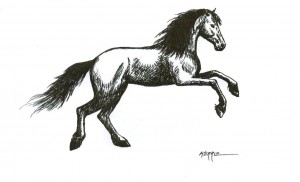 I started drawing horses when I was four. I remember I had been given a large book of colored construction paper, and if I had been more frugal I might have understood that such a variety of colors could have been used more creatively. But I made a horse drawing on each page of that book, using a black marker, creating rather pudgy replicas of the species, usually only supplying them with the two legs nearest the viewer, but never forgetting the feed pan for them to eat out of. All of my first drawn horses were happily eating grain from their feed pans.
I started drawing horses when I was four. I remember I had been given a large book of colored construction paper, and if I had been more frugal I might have understood that such a variety of colors could have been used more creatively. But I made a horse drawing on each page of that book, using a black marker, creating rather pudgy replicas of the species, usually only supplying them with the two legs nearest the viewer, but never forgetting the feed pan for them to eat out of. All of my first drawn horses were happily eating grain from their feed pans.
The artistic tendencies came as naturally to me as the horse craze. My grandmother was a good artist. Her painted landscapes, wildlife, and other drawings hung framed around our house, and she loved watching me draw, always giving me encouraging words for my efforts. My mom was also an accomplished artist, and had taught many of her students to draw and paint, so I had a lot of help as I started to create my own things.
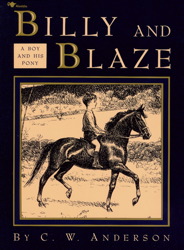 As a child, I loved the horse stories by C. W. Anderson, not only for their adventures, but also for the beautiful detailed pencil drawings on each page. C. W. Anderson was one of my earliest inspirations for drawing horses, and I read every book I could find in the library written by him. His stories of Billy and Blaze were thrilling, and always had a good plot to them, where the trusty horse usually saved the day. The drawings were very well shaded, and I learned some methods of pencil drawing just by looking at his drawings.
As a child, I loved the horse stories by C. W. Anderson, not only for their adventures, but also for the beautiful detailed pencil drawings on each page. C. W. Anderson was one of my earliest inspirations for drawing horses, and I read every book I could find in the library written by him. His stories of Billy and Blaze were thrilling, and always had a good plot to them, where the trusty horse usually saved the day. The drawings were very well shaded, and I learned some methods of pencil drawing just by looking at his drawings.
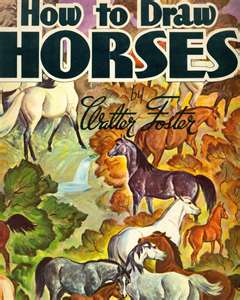 My mom had some drawing books by Walter Foster that I loved to work through. They gave step by step illustrations for creating drawings, and it simplified the process enough for me to follow the steps. The first would be simple lines or circles, followed by more refined lines and added features, and would end by adding shading and intricate details until the finished product was very lifelike. It was this type of drawing that I enjoyed the most. The book How To Draw Horses, by Walter Foster, is one of the best resources for a beginning artist with a love for horses. I learned so much from the many Walter Foster books my mom let me use.
My mom had some drawing books by Walter Foster that I loved to work through. They gave step by step illustrations for creating drawings, and it simplified the process enough for me to follow the steps. The first would be simple lines or circles, followed by more refined lines and added features, and would end by adding shading and intricate details until the finished product was very lifelike. It was this type of drawing that I enjoyed the most. The book How To Draw Horses, by Walter Foster, is one of the best resources for a beginning artist with a love for horses. I learned so much from the many Walter Foster books my mom let me use.
Here is an example of the step by step process that the Walter Foster books use: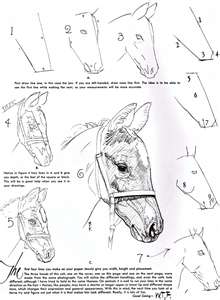
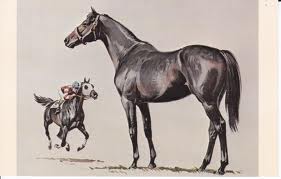 My absolute favorite horse artist was Sam Savitt. Mom had a framed print of one of his paintings hanging on the wall, a big brown gelding in an English bridle. I loved the look of that horse, it was so lifelike I thought I could jump on his back and leap over the stone wall at the far edge of the painting. That was the type of drawing I really wanted to be able to do, because Sam Savitt’s horses lived and breathed, they were so realistic. No other artist could create such a complete and lifelike drawing in fewer pencil strokes than Sam Savitt. He illustrated many books about horses and dogs, and his art is easily recognizable, as no one else compares in drawing and painting horses in action.
My absolute favorite horse artist was Sam Savitt. Mom had a framed print of one of his paintings hanging on the wall, a big brown gelding in an English bridle. I loved the look of that horse, it was so lifelike I thought I could jump on his back and leap over the stone wall at the far edge of the painting. That was the type of drawing I really wanted to be able to do, because Sam Savitt’s horses lived and breathed, they were so realistic. No other artist could create such a complete and lifelike drawing in fewer pencil strokes than Sam Savitt. He illustrated many books about horses and dogs, and his art is easily recognizable, as no one else compares in drawing and painting horses in action.
I never developed as easy a hand at painting as I had with drawing. If I had taken lessons, I might have mastered the colors and knowledge of lighting necessary to paint in color. I did quite a few acrylic paintings of horses when I was in high school, and sold a few in tack shops here and there, but most of them still hang in my parent’s house. I don’t know that I could do as well now if I tried, having not painted in many years. But they are a testament to my hard work when I was a teenager, and I’m kind of fond of them.
If you’re born with an art inclination, I would urge you to find your passion and develop it. It doesn’t always take natural talent to succeed at something you love–find your own way and do what you love. For me, it was horses that always appeared on my paper, and they inspired me to keep drawing. Today as I watch our daughter draw fairies with big hair and ornate dresses, I give her the same advice: Draw what you love.
I draw horses in this fashion:
1. Find an idea you like. Either look at your blank sheet of paper and imagine the horse in your mind as you see it, or else use a photo of a horse to look at.

2. Sketch a simple outline using easy shapes like circles and sticks to form the outline of your drawing. This one step is the most important, and if you have the proportions wrong on this step, they will continue to be wrong throughout the drawing. (Case in point, my example drawing below is way too short in the barrel. It started that way in this sketch, but went unnoticed until I had finished the drawing.)
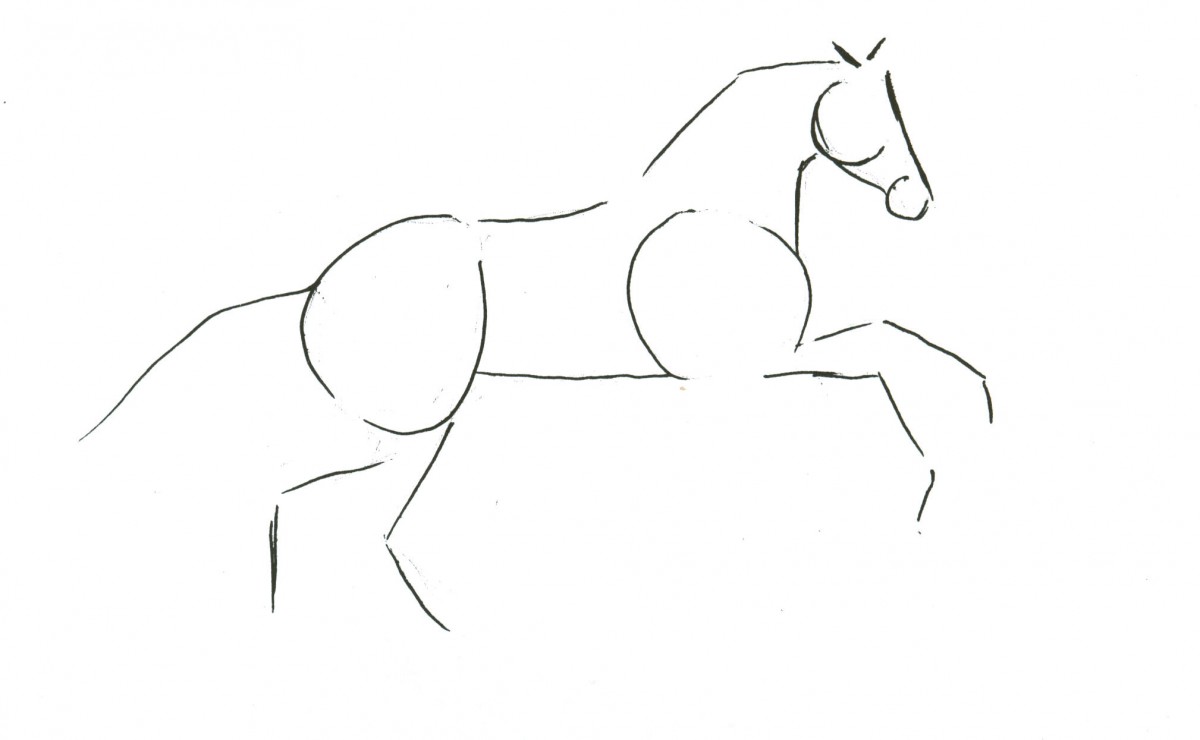
3. Add more fluid lines and finish the framework of the drawing.
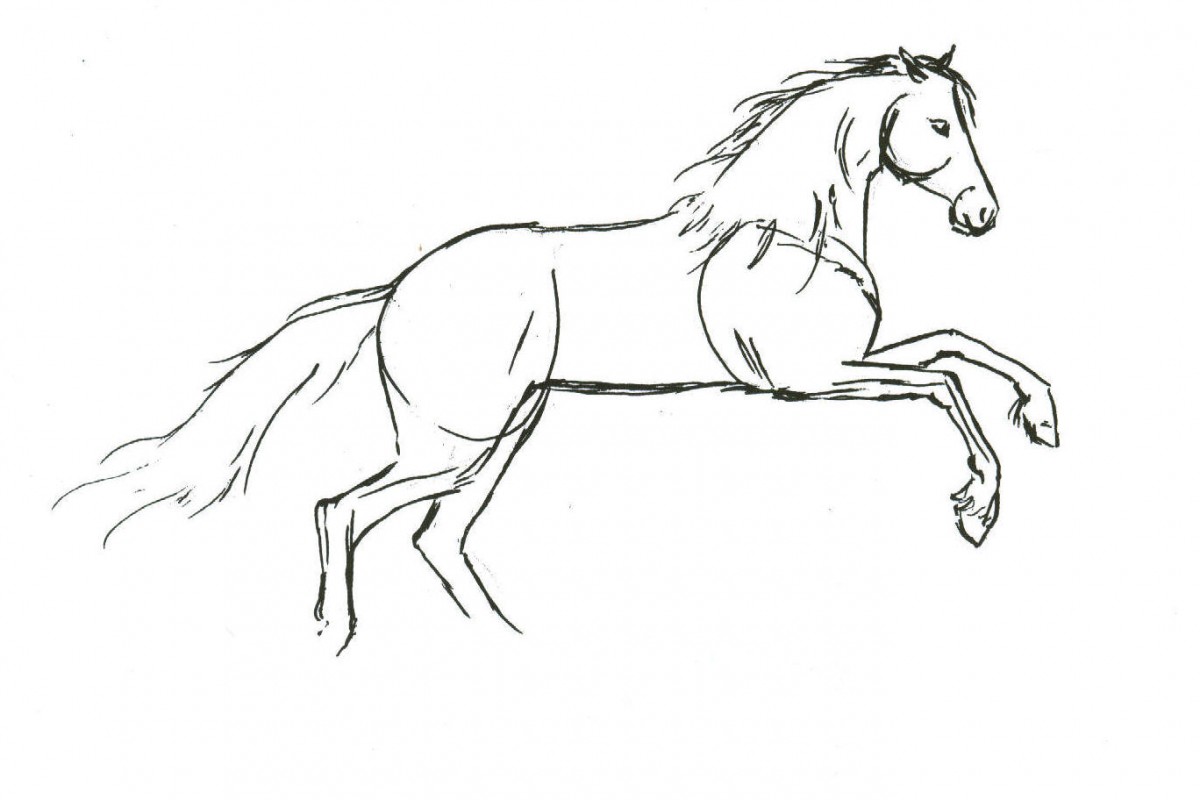
4. Add shading, color in the eyes, leaving a small highlight near the light source, fill in shadows with small lines or cross hatching, define muscles, finish the details. (Looking at this later, it appears that the rear end and front end of the horse belong to two separate bodies–again, it is the fault of too short of a barrel in step 2, so if I were to draw this again I would make the barrel longer.)
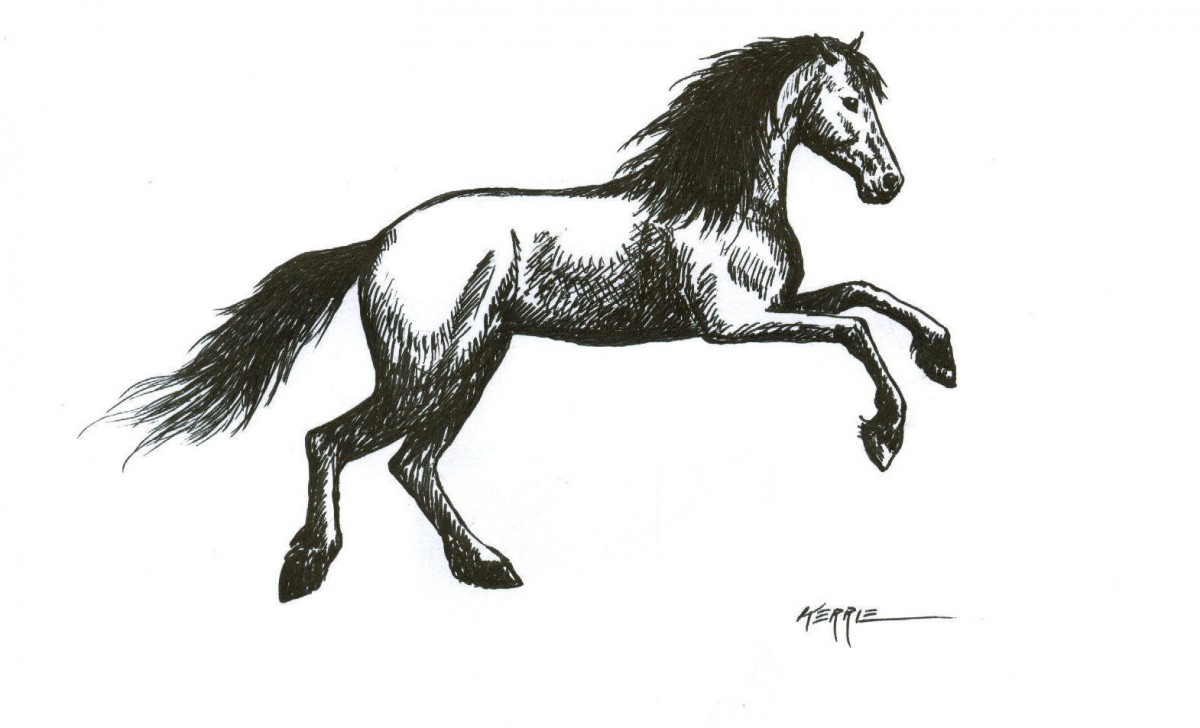
Happy drawing!

